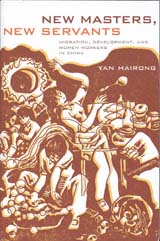-
In recent decades China, the world's fastest-growing economy has seen a sharp increase of its rural-urban migration flows. The abundance of a booming consumer economy has also sparked a high demand for new employment patterns, and created newer forms of exploitation involving rural citizens who migrate to the cities to work as domestic servants for the expanding middle class.
-
Despite this rising phenomenon and the ample literature on rural-urban migration, little has been written about women domestic workers who find a new source of livelihood in China's sprawling cities. Drawing on a vast body of ethnographic data supplemented by historical literature, New Masters, New Servants by Yan Hairong focusses solely on the under-researched topic of domestic workers in Beijing.
-
Through the six chapters, the dominant themes are the solitude, isolation and exploitation that rural to urban migration entails. The book starts with an overview of China post-Mao reforms and the evolution of growth and class, followed by a discussion on the emaciation of the countryside, which in post-Mao modernity becomes the opposite of the civilised city. Yan interprets rural women's migration, particularly in the case of young women, as a troubled process of subject formation in China's development discourse (p. 37), and argues that this reconfigured rural-urban relationship is constitutive of rural women's desire for the city (p. 51). While labour mobility continues to be celebrated by the party cadre as a symbol of post-Mao development, Yan argues that the country's race for modernisation has robbed the countryside of its ability to serve as a place for rural youth to construct a meaningful identity.
-
In chapter 2, Yan deconstructs the meaning of mind and body, gender and class by shifting the focus from the countryside to the city. The author links the existence and rise of the class of dagongmei (打工妹) workers or 'servants', to the increasingly prominent 'intellectuals'. Dagongmei's pursuit of a modern urban identity is the necessary component in the strategy to assist intellectuals (Beijing upper and middle-class) in contributing toward the post-Mao project of modernisation. Recruiting and training a baomu (保姆 domestic worker) thus becomes a matter of class, and a process of restructuring sociality in the changing relationships between city and countryside.
-
For baomu to be successful in the urban economy, suzhi (素质) is a crucial element. Suzhi is a multidimensional term that refers to qualities of civility, self-discipline, and modern consciousness (chapter 3). In Yan's perspective, migrant women and Chinese rural masses in general, are urged and expected to pursue their suzhi and class mobility, and thus support China in becoming a competitive player in the field of global capital. In China's metamorphosis to a post-socialist market economy, development is the 'salvation' that can be acquired in the cities and brought back to the villages so that the countryside can become a theatre of suzhi production (p. 130).
-
The final chapters (4, 5 and 6) are probably the most provocative and stimulating part of this volume. Hedonistic consumption is greatly celebrated in the new China as the key contributor and indicator of the transformation brought by the market economy. In chapter 4, Yan describes the process through which domestic migrant workers are recruited and placed, while the last two chapters analyse the dual discourse of self development (ziwo fazhan 自我发展) and migrants' rights though the free-market paradigm. In chapter 4, Yan illustrates the instruments that local governments are using to encourage and celebrate the modernising and transformative effect of migration. The images of two 'Westernised' women returning to Anhui typify the mirage of modernity, and as a result development, and are the ultimate representation of cosmopolitan subjects. Nonetheless, these images accentuate the contradictions between production and consumption and the universal migrant conundrum of identity and belonging, which will be examined in the following chapters. Chapters 5 and 6 highlight how Chinese domestic workers are the simultaneous protagonists of production, consumption and exploitation in the post-socialist market revolution. Though migrant workers are looked on as the 'reserve army of labour' of the expanding market economy, as well as the most promising agents of self-development and social mobility (p. 190), these women continue to endure the discrimination and exploitation dictated by the neo-liberal economic model.
-
Not often does one come across a book which so meticulously depicts the process of subjectivity and belonging as New Masters, New Servants. The anthropological and contextual approach makes it a useful text for better understanding Chinese society in general and its gender relations in particular, and an interesting volume for scholars of gender studies, migration, Chinese studies and social anthropology. The particular strength of this book is its mapping out of the formation and development of a domestic labour identity, and the attempt to comprehend the lives of migrant domestic workers who live in the shadow of an increasingly globalised China.
|



